HTC Flyer doooool test: after a month of operation
Quite rarely we do two reviews on the same product, and not so often the opinion about the gadget changes after long testing. HTC gadgets were lucky twice, and for the first time - in quotes: I recognized the HTC Desire Z smartphone as the biggest disappointment of 2010, although at first I liked it. With the HTC Flyer, everything happened exactly the opposite: initially I wondered what place in my gadget-luggage could take a 7-inch diagonal subtelephone, but Flyer quickly integrated into my coordinate system.
Under the cut - our first review of HTC Flyer from baragol , as well as my text.
')
This is the first HTC Flyer video review, which Ivan Zvyagin did, as they say, “hot on the heels”.
And here you can read the text review of Ivan.
Well, this is my text, written for the magazine "Results" and the site Nomobile.ru
Tablets, like 3D-TVs and a lot of other rigidly imposed technical workplaces, are slowly but inexorably entering our homes. Now it's not so cool to get an iPad in the metro: there is always a friend in the car. But if Apple has already approved large tablets with a diagonal of 10 inches as the main format, then smaller tablets are still perceived with frowning eyebrows: why do we need them? The test model HTC Flyer is the second seven-inch tablet, which appeared in our market after the Samsung Galaxy Tab.
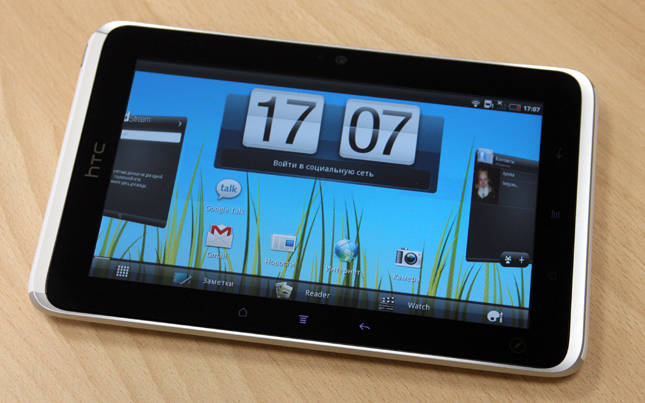
Immediately five, no questions asked! If you habitually divide the tablet world into “iPads” and “other tablets,” then HTC Flyer is by far the most beautiful of all. The metal case with white plastic inserts on the heel looks very fresh and clearly indicates the premium class of the product. The white border is also visible from the front, and thanks to the thickening at the bottom, it is comfortable to hold in your hand - there is no paranoid feeling, as in iPad2, that it is about to slip. The only thing you can find fault is that the SIM-card slot is located strangely, under the upper insert, which cannot be opened without skill, and in my sample a gap appeared in a month.
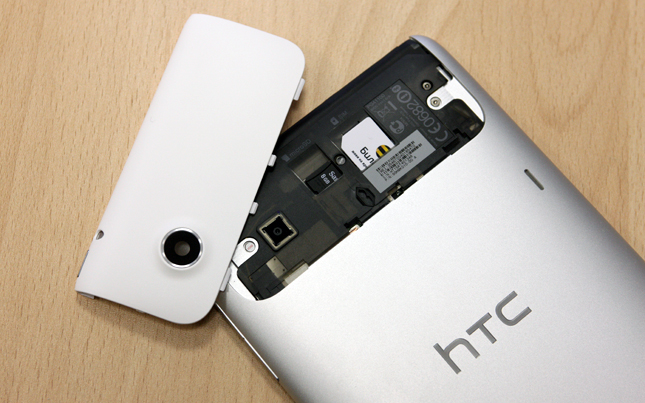
Many complain that the tablet is hard to hold on to the weight for a long time, but for me it is just the way I used it most of the time, and not on the surface of, say, a table. Although this is solely because I do not have small hands - I quickly adapted to type the text with my thumbs, holding the tablet vertically. With big “ipads” such a trick did not work. But in a horizontal position a ten-finger set is impossible, which was possible with the iPad. I didn’t have two things in the design: these are coasters for installing the tablet at an angle (I am waiting for HTC to have the same wonderful cover that Apple invented) and a USB connector with a host function so that you can connect flash drives and hard drives to the tablet. And still the white cover qualitatively collects all the dirt and quickly loses its presentation.
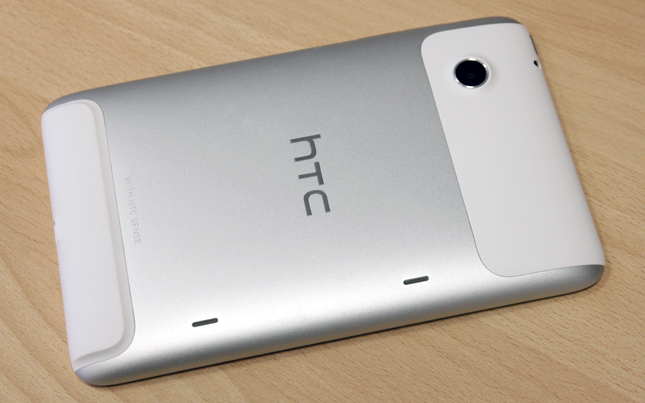
At the ends there are three narrow hardware keys: the power on and the paired volume button, they are groped well, no complaints. In Android tablets, as well as in “iPads,” there is also a Home button, but it is touch, followed by the context menu icon and the return button. And here the strip of control pictograms is duplicated on the horizontal side when the tablet is rotated, but only to the left, so HTC Flyer, unlike the Apple iPad, has only two grip options, not four.
The main feature of the tablet in HTC is the presence of an electronic pen, which is not attached to the tablet, but is inserted into the white leather case, which is included in the package. At first you think - what a kindergarten, do users of this tablet really often paint on mustaches and horns in photos? However, I managed to quickly build in the stylus into my ecosystem, I got used almost immediately. You can work with the tablet with your fingers - the screen is capacitive with multi-touch support, but with the stylus the functionality expands. If you touch the screen with a pen, a snapshot is automatically taken. And everything - draw anything. You can make some notes directly on the web pages and immediately publish them on Facebook, Twitter or save in the gallery. You can sign documents and copy over photos, and in some applications, such as an installed reader, you can edit not the screenshot, but the page content itself.
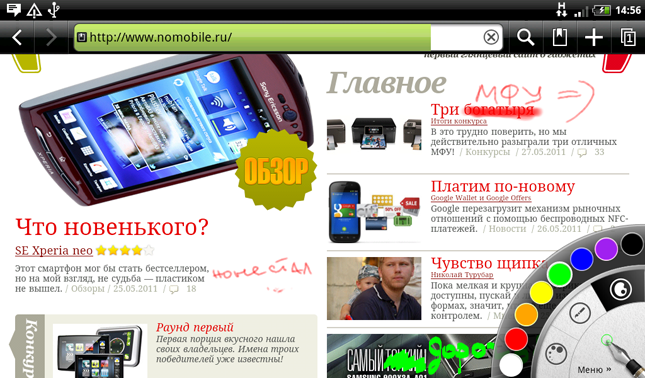
And all notes will be bookmarked. There are two buttons on the stylus: when you hold one, the pen works like an eraser, the other allows you to mark text in some applications. In the touch menu there is another button that launches the stylus control menu: you can choose the thickness, color and type of lines, undo the last actions, take screenshots and enter the data directly into an Evernote notebook. I am a long-time user of the Evernote service - this is such an online notepad that is accessible from any device and just a browser, and HTC Flyer integration with him personally pleased me very much, I recommend all lovers to take notes with a pen to look at a bunch of Flyer and Evernote.

Nothing outstanding: the matrix is quite average, the resolution is also not beyond. The screen is comparable to the Samsung Galaxy Tab of the first version, but loses the second iteration of Tab 8.9 (8.9 inches diagonal, resolution 1280x800 pixels). It glares strongly at the sun, it is necessary to peer into the picture.
The tablet is quite powerful: a single-core processor is overclocked to 1.5 GHz, 1 GB of RAM is enough for Android not to slow down. And the truth is, everything flies in the menu, unlike the slightly thoughtful Samsung Galaxy Tab.

This is not a tablet version of Android 3.0, but a smartphone version 2.3, and many consider this to be the main drawback. I am chatting: Android 3.0 is still very raw and unstable, but here, on top of 2.3, the HTC Sense shell adapted for tablets is stretched, and this bundle works much better. However, HTC promises to add support for 3.0 soon.

During the announcement of the HTC Flyer in Barcelona, Taiwanese were surprised by a serious software and service binding, which creates a fairly competitive advantage for the tablet. The main thing is the gaming service Onlive, which allows you to use the tablet as a game console. In second place is the HTC Watch service, access to the world video library: you can watch trailers and buy movies. But both of these services in Russia do not work, although Watch promises to launch in September. But there are two readers at once: one with a catalog of English-language books, but ePub format support, the second - exclusively for the press, in the Russian section there were 72 publications, including Itogi magazine. Also built-in office suite Polaris Office, PDF-viewer, Sound Hound music recognizer and even the little things. By the way, there are no dialers in the system: you cannot take a call to the SIM card and you cannot call from the tablet without Skype (unlike Samsung Galaxy Tab), but you can work with SMS.
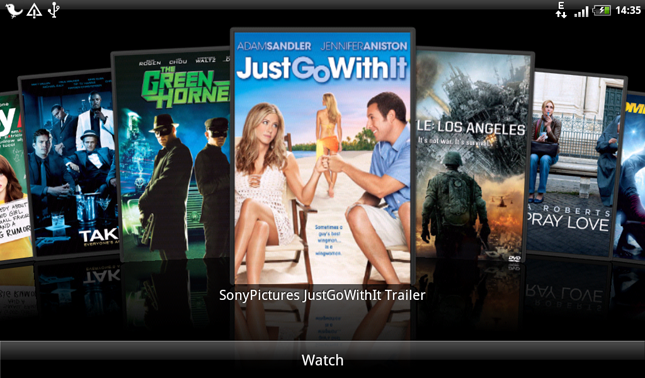
Both iPads torpedo their competitors with battery life, and HTC Flyer got the biggest hole. He has never pulled out even five hours with me at full load - this is completely frivolous and substantially levels the advantages. The tablet has “sleep mode”, a special mode, when activated, which disables all wireless interfaces. This mode is automatically turned on and off at a specified time, which can be set in the settings. But it helps slightly.
If large 10-inch tablets are primarily media players and gaming devices, then 7-inch tablets are more focused on business and work on the Internet, you can work with them on the go. And in this context, I like the 7-inch much more.
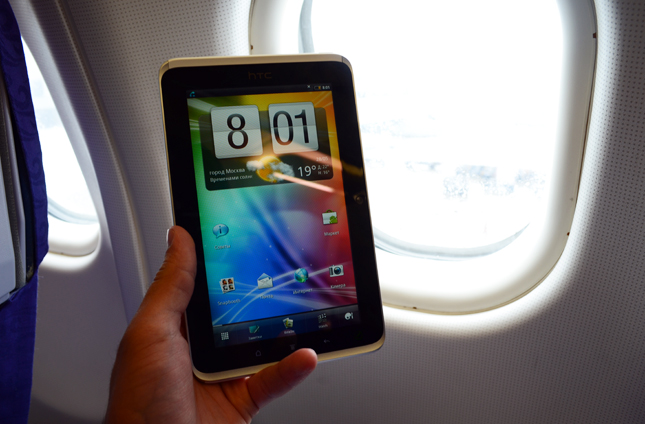
With a strong desire, this compact, cute and functional tablet can be embedded in your life, especially if you are used to working with the stylus and the Evernote service, and you deny Apple for religious reasons. Still, HTC Flyer cannot cost so much and work so little without an outlet. And, unfortunately, there are no modifications (for example, spread on built-in memory, for example) and other color solutions.
Under the cut - our first review of HTC Flyer from baragol , as well as my text.
')
This is the first HTC Flyer video review, which Ivan Zvyagin did, as they say, “hot on the heels”.
And here you can read the text review of Ivan.
Well, this is my text, written for the magazine "Results" and the site Nomobile.ru
White bone
Tablets, like 3D-TVs and a lot of other rigidly imposed technical workplaces, are slowly but inexorably entering our homes. Now it's not so cool to get an iPad in the metro: there is always a friend in the car. But if Apple has already approved large tablets with a diagonal of 10 inches as the main format, then smaller tablets are still perceived with frowning eyebrows: why do we need them? The test model HTC Flyer is the second seven-inch tablet, which appeared in our market after the Samsung Galaxy Tab.

Design
Immediately five, no questions asked! If you habitually divide the tablet world into “iPads” and “other tablets,” then HTC Flyer is by far the most beautiful of all. The metal case with white plastic inserts on the heel looks very fresh and clearly indicates the premium class of the product. The white border is also visible from the front, and thanks to the thickening at the bottom, it is comfortable to hold in your hand - there is no paranoid feeling, as in iPad2, that it is about to slip. The only thing you can find fault is that the SIM-card slot is located strangely, under the upper insert, which cannot be opened without skill, and in my sample a gap appeared in a month.

Ergonomics and design
Many complain that the tablet is hard to hold on to the weight for a long time, but for me it is just the way I used it most of the time, and not on the surface of, say, a table. Although this is solely because I do not have small hands - I quickly adapted to type the text with my thumbs, holding the tablet vertically. With big “ipads” such a trick did not work. But in a horizontal position a ten-finger set is impossible, which was possible with the iPad. I didn’t have two things in the design: these are coasters for installing the tablet at an angle (I am waiting for HTC to have the same wonderful cover that Apple invented) and a USB connector with a host function so that you can connect flash drives and hard drives to the tablet. And still the white cover qualitatively collects all the dirt and quickly loses its presentation.

Buttons
At the ends there are three narrow hardware keys: the power on and the paired volume button, they are groped well, no complaints. In Android tablets, as well as in “iPads,” there is also a Home button, but it is touch, followed by the context menu icon and the return button. And here the strip of control pictograms is duplicated on the horizontal side when the tablet is rotated, but only to the left, so HTC Flyer, unlike the Apple iPad, has only two grip options, not four.
Stylus
The main feature of the tablet in HTC is the presence of an electronic pen, which is not attached to the tablet, but is inserted into the white leather case, which is included in the package. At first you think - what a kindergarten, do users of this tablet really often paint on mustaches and horns in photos? However, I managed to quickly build in the stylus into my ecosystem, I got used almost immediately. You can work with the tablet with your fingers - the screen is capacitive with multi-touch support, but with the stylus the functionality expands. If you touch the screen with a pen, a snapshot is automatically taken. And everything - draw anything. You can make some notes directly on the web pages and immediately publish them on Facebook, Twitter or save in the gallery. You can sign documents and copy over photos, and in some applications, such as an installed reader, you can edit not the screenshot, but the page content itself.

And all notes will be bookmarked. There are two buttons on the stylus: when you hold one, the pen works like an eraser, the other allows you to mark text in some applications. In the touch menu there is another button that launches the stylus control menu: you can choose the thickness, color and type of lines, undo the last actions, take screenshots and enter the data directly into an Evernote notebook. I am a long-time user of the Evernote service - this is such an online notepad that is accessible from any device and just a browser, and HTC Flyer integration with him personally pleased me very much, I recommend all lovers to take notes with a pen to look at a bunch of Flyer and Evernote.

Display
Nothing outstanding: the matrix is quite average, the resolution is also not beyond. The screen is comparable to the Samsung Galaxy Tab of the first version, but loses the second iteration of Tab 8.9 (8.9 inches diagonal, resolution 1280x800 pixels). It glares strongly at the sun, it is necessary to peer into the picture.
Functional
The tablet is quite powerful: a single-core processor is overclocked to 1.5 GHz, 1 GB of RAM is enough for Android not to slow down. And the truth is, everything flies in the menu, unlike the slightly thoughtful Samsung Galaxy Tab.

Shell
This is not a tablet version of Android 3.0, but a smartphone version 2.3, and many consider this to be the main drawback. I am chatting: Android 3.0 is still very raw and unstable, but here, on top of 2.3, the HTC Sense shell adapted for tablets is stretched, and this bundle works much better. However, HTC promises to add support for 3.0 soon.

Soft
During the announcement of the HTC Flyer in Barcelona, Taiwanese were surprised by a serious software and service binding, which creates a fairly competitive advantage for the tablet. The main thing is the gaming service Onlive, which allows you to use the tablet as a game console. In second place is the HTC Watch service, access to the world video library: you can watch trailers and buy movies. But both of these services in Russia do not work, although Watch promises to launch in September. But there are two readers at once: one with a catalog of English-language books, but ePub format support, the second - exclusively for the press, in the Russian section there were 72 publications, including Itogi magazine. Also built-in office suite Polaris Office, PDF-viewer, Sound Hound music recognizer and even the little things. By the way, there are no dialers in the system: you cannot take a call to the SIM card and you cannot call from the tablet without Skype (unlike Samsung Galaxy Tab), but you can work with SMS.

Autonomous work
Both iPads torpedo their competitors with battery life, and HTC Flyer got the biggest hole. He has never pulled out even five hours with me at full load - this is completely frivolous and substantially levels the advantages. The tablet has “sleep mode”, a special mode, when activated, which disables all wireless interfaces. This mode is automatically turned on and off at a specified time, which can be set in the settings. But it helps slightly.
Scenarios
If large 10-inch tablets are primarily media players and gaming devices, then 7-inch tablets are more focused on business and work on the Internet, you can work with them on the go. And in this context, I like the 7-inch much more.

Summary
With a strong desire, this compact, cute and functional tablet can be embedded in your life, especially if you are used to working with the stylus and the Evernote service, and you deny Apple for religious reasons. Still, HTC Flyer cannot cost so much and work so little without an outlet. And, unfortunately, there are no modifications (for example, spread on built-in memory, for example) and other color solutions.
Source: https://habr.com/ru/post/122888/
All Articles